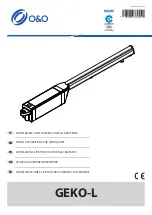
Adjustment Step 2
Adjust the Force
Too much force on the door will interfere with
the proper operation of the safety reverse
system.
The door might not reverse properly
when required and could seriously injure or kill
someone under it. Do not increase the force
beyond the minimum amount required to close
the door. Do not use the force adjustments to
compensate for a binding or sticking garage
door. Test the safety reverse system following
all adjustments to force levels. See page 30.
Force adjustment controls are located on the back
panel of the opener. Force adjustment settings
regulate the amount of power required to open and
close the door.
The door will
stop in the up direction if anything
interferes with its travel. The door will
reverse in the
down direction if anything interferes with its travel
(including binding or unbalanced doors).
If the forces are set too light, door travel may be
interrupted by
nuisance reversals in the down
direction and
stops in the up direction. Weather
conditions can affect the door movement, so
occasional adjustment may be needed.
The maximum force adjustment range is 260
degrees, about 3/4 of a complete turn. Do not force
controls beyond that point. Turn force adjustment
controls with a screwdriver.
Force
Adjustment
Controls
Back Panel
of Opener
KG
KG
M.D.C. CERT. NO.
1
3
9
7
5
132C2105-1
PART NO:
Nº DE PIÈCE:
D.O.C. CERT. NO.
DATE:
Sears Roebuck & Co.
Sears Canada Inc., Toronto
Assembled in Mexico - Assemblé du Mexique
PAT. #RE29,525; 4,750,201; 4,806,930 Other Patents Pending.
AVERTISSEMENT: Pour réduire les risques de
blessures mortelles par happement, après tout
réglage de la force de déclenchement ou des
seuils de fin de course s'assurer que le sens de
la course s'inverse lorsque la porte entre en
contact avec un object de 13 mm (1 po) de
hauteur (ou un madrier de 2 x 4 de section, à
plat) posé sur le sol. Effectuer les reglages
selon les procédures décrites dans la notice.
1
3
9
7
5
1
2
3
How and When to Adjust the Forces
Test the DOWN (close) force
Grasp the door bottom when the door is about
halfway through DOWN (close) travel. The door
should reverse. (Reversal halfway through down
travel does not guarantee reversal on a one-inch
obstruction. See page 30.) If the door is hard to
hold or doesn't reverse, decrease the DOWN (close)
force by turning the control counterclockwise.
Make 10 degree turn adjustments until the door
reverses normally. After each adjustment, run the
opener through a complete cycle.
Test the UP (open) force
Grasp the door bottom when the door is about
halfway through UP (open) travel. The door should
stop. If the door is hard to hold or doesn't stop,
decrease UP (open) force by turning the control
counterclockwise.
Make 10 degree turn adjustments until the door
stops easily. After each adjustment, run the opener
through a complete travel cycle.
If the door doesn't open
at least 5 feet
Increase UP (Open) force by turning the control
clockwise. Make 10 degree turn adjustments until
door opens completely. Re-adjust the UP limit if
necessary. After each adjustment, run the opener
through a complete travel cycle.
If the door
reverses during the down (close)
cycle and the opener lights aren't flashing
Increase DOWN (close) force by turning the control
clockwise. Make 10 degree turn adjustments until the
door completes a close cycle. After each adjustment,
run the opener through a complete travel cycle. Do
not increase the force beyond the minimum
amount required to close the door.
29
Adjustment Label
KG
KG
1
3
9
7
5
1
3
9
7
5
WARNING












































